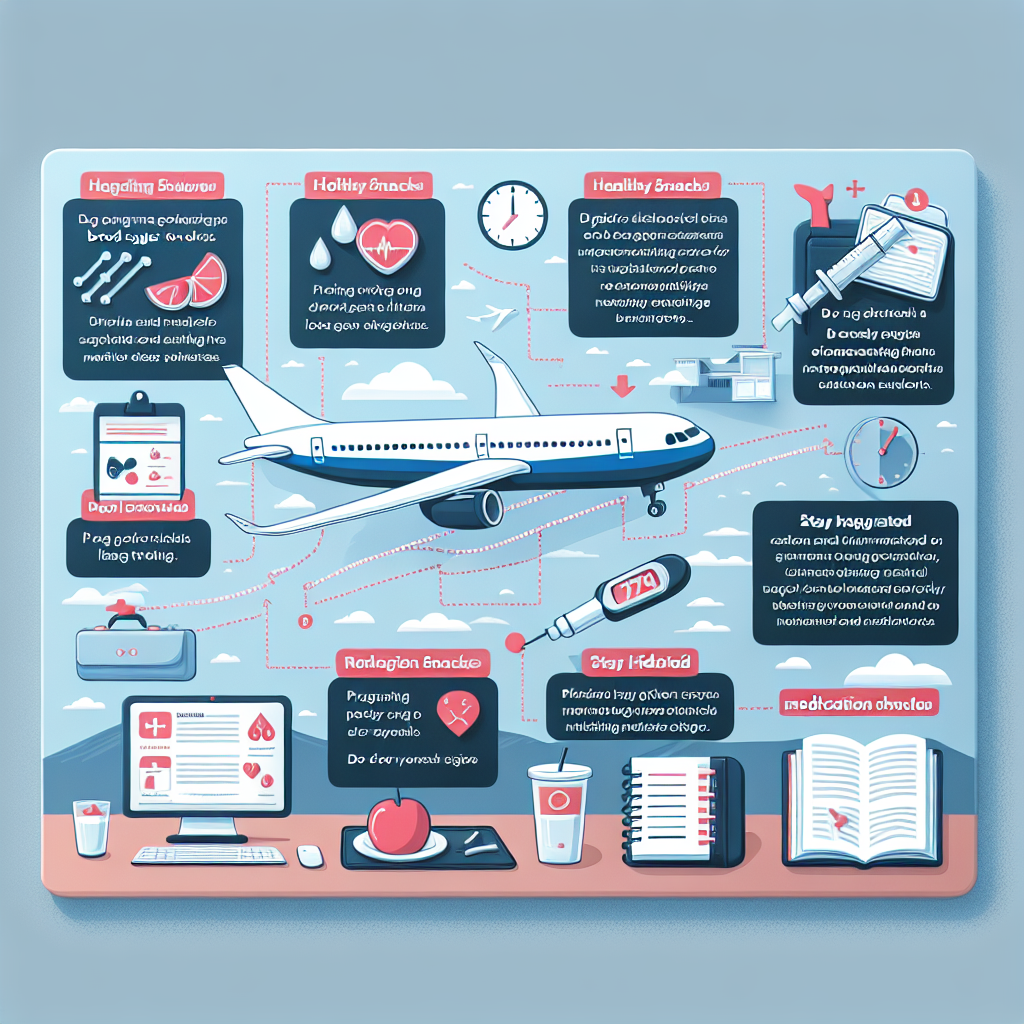Traveling can be exciting, especially when you have the opportunity to embark on a long flight. However, for individuals managing blood sugar levels, this can pose a challenge. Whether you have diabetes or simply need to monitor your blood sugar, it is crucial to take precautions during extended flights. In this article, you will discover some helpful tips and strategies to effectively manage your blood sugar levels while soaring through the skies, ensuring a safe and enjoyable journey.

Recognize the Challenge of Long Flights
Long flights can present unique challenges when it comes to managing blood sugar levels. Understanding how glucose regulation works, the effects of stress and sleep disruption, and the impact of limited food options is crucial in maintaining stable blood sugar levels throughout the journey.
Understanding glucose regulation
Glucose regulation is the process by which the body maintains a steady level of glucose in the blood. It is essential for proper bodily functions and overall health. During long flights, it can be challenging to regulate glucose levels due to factors such as limited food options, changes in meal timings, and disrupted sleep patterns.
Effects of stress and sleep disruption
Stress and sleep disruption can have a significant impact on blood sugar levels. When you’re stressed, the body releases stress hormones like cortisol, which can cause an increase in blood sugar levels. Additionally, lack of sleep can disrupt the body’s ability to regulate blood sugar, leading to fluctuations and potential imbalances.
Impact of limited food options
During long flights, the availability of food options may be limited, especially for individuals with specific dietary restrictions. This can make it challenging to maintain a balanced and nutritious meal plan, potentially leading to irregular eating patterns and difficulties in managing blood sugar levels.
Pre-Flight Preparation
Proper pre-flight preparation is crucial in managing blood sugar levels effectively during the journey. Consulting with your healthcare provider, preparing a travel kit, and planning meals and snacks in advance can help you stay on track.
Consulting with healthcare provider
Before embarking on a long flight, it is advisable to consult with your healthcare provider, especially if you have specific medical conditions or take medication that affects glucose levels. Your healthcare provider can provide guidance on how to navigate the challenges of managing blood sugar during the flight and offer personalized recommendations.
Preparing a travel kit
A well-prepared travel kit is essential when managing blood sugar levels during flights. Make sure to pack all necessary supplies, such as glucose meters, test strips, insulin (if needed), snacks, and any other diabetic medications. Having everything easily accessible will ensure you can monitor and manage your blood sugar effectively.
Planning meals and snacks
Planning your meals and snacks in advance is essential to maintain stable blood sugar levels. Consider packing nutrient-dense snacks like nuts, seeds, and low-sugar protein bars. Additionally, research the food options available on the flight and choose meals that are lower in carbohydrates and higher in protein and fiber to support better glycemic control.
Managing Food Intake
Making wise choices when it comes to in-flight meals and carrying nutritious snacks can go a long way in managing blood sugar levels during long flights. It is important to choose meals that are balanced, carry snacks for better glycemic control, and maintain meal timings to avoid fluctuations.
Choosing nutritious in-flight meals
When selecting in-flight meals, opt for options that are lower in carbohydrates and higher in protein and fiber. This can help prevent rapid spikes and drops in blood sugar levels. Look for meals that include lean protein sources like chicken or fish, accompanied by vegetables and whole grains.
Carrying snacks for better glycemic control
Carrying snacks that are diabetic-friendly and provide a good balance of nutrients is essential for managing blood sugar levels. Nuts, seeds, low-sugar protein bars, and fresh fruits are excellent options. These snacks can help you control your hunger and prevent low blood sugar episodes.
Maintaining meal timings to avoid fluctuations
Keeping your meal timings consistent can help regulate blood sugar levels during long flights. Aim to eat meals and snacks at the same times you would normally consume them. By sticking to a regular schedule, you can avoid fluctuations and maintain stable blood sugar levels.
Hydration and Glucose Levels
Maintaining proper hydration plays a crucial role in managing blood sugar levels during long flights. Understand the health benefits of staying hydrated, avoid sugary and alcoholic drinks, and opt for water, herbal tea, or low sodium beverages.
Health benefits of staying hydrated
Staying hydrated is essential for overall health, and it can also contribute to better blood sugar management. Proper hydration supports kidney function, which is crucial in removing excess glucose from the bloodstream. It also helps prevent dehydration, which can lead to increased blood sugar levels.
Avoiding sugary and alcoholic drinks
It is important to avoid sugary and alcoholic drinks during the flight, as they can cause rapid spikes in blood sugar levels. These beverages often contain high amounts of added sugars or alcohol, which can disrupt glucose regulation. Instead, opt for water, herbal tea, or low sodium beverages to stay hydrated without negatively impacting your blood sugar.
Opt for water, herbal tea or low sodium beverages
Water is the best choice for hydration during long flights. It contains no added sugars or calories and is essential for overall health. Herbal teas without added sugars or sweeteners can also be a good option. Alternatively, opt for low sodium beverages to supplement your hydration without affecting your blood sugar levels.

Physical Activity and Blood Sugar
Maintaining physical activity levels during a long flight can help regulate blood sugar levels. Walking around the cabin regularly, performing simple in-seat exercises, and balancing rest time can all contribute to better glucose control.
Walk around the cabin regularly
Sitting for extended periods can lead to reduced blood circulation and a decrease in glucose utilization. To counteract this, make it a point to walk around the cabin regularly. Take short walks every hour or so to keep your blood flowing and your body active.
Performing simple in-seat exercises
In addition to walking, you can also perform simple in-seat exercises to maintain physical activity during the flight. Ankle rolls, seated leg lifts, and shoulder rolls are some examples of exercises you can do without leaving your seat. These movements help keep your muscles engaged and promote blood circulation.
Balancing rest time
While physical activity is crucial, it’s also important to balance it with adequate rest time. Long flights can be exhausting, and getting enough rest is essential for overall well-being and blood sugar control. Find a comfortable position, use pillows or blankets for support, and make sure to get enough sleep to avoid disruptions in glucose regulation.
Importance of Regular Monitoring
Regular monitoring of blood sugar levels is vital during long flights. Frequent blood glucose checks, understanding the impact of jet lag on glucose levels, and using technology for instant results can help you stay aware of your current status and make necessary adjustments.
Need for frequent glucose checks
Frequent glucose checks are necessary to monitor your blood sugar levels throughout the flight. The stress, changes in meal timings, and potential disruptions in sleep patterns can all affect your glucose levels. By regularly checking your blood sugar, you can identify any fluctuations and take appropriate actions to maintain stability.
Understanding the impact of jet lag on glucose levels
Jet lag can have an impact on blood sugar levels due to disrupted sleep patterns and changes in meal timings. When traveling across multiple time zones, it’s crucial to be mindful of these potential effects. Speak with your healthcare provider to understand how jet lag may affect your glucose levels and develop a plan accordingly.
Using technology for instant results
Advancements in technology have made it easier than ever to monitor blood sugar levels instantly. Utilize glucose meters and continuous glucose monitoring systems to get accurate and instant results. These devices can provide valuable insights into your glucose levels during the flight, allowing you to make necessary adjustments to maintain stability.

Jet Lag and Blood Sugar Levels
Understanding how jet lag affects hormone regulation and the role of melatonin in glucose regulation is essential when managing blood sugar levels during long flights. Adjusting meal and medication timings based on the destination’s time zone can help maintain stable blood sugar levels.
Understanding how jet lag affects hormone regulation
Jet lag can disrupt the body’s natural hormone regulation, including those involved in glucose control. The combination of changes in sleep patterns and meal timings can result in hormonal imbalances, potentially leading to fluctuations in blood sugar levels. By understanding these effects, you can take appropriate measures to minimize disruptions.
Role of melatonin in glucose regulation
Melatonin, a hormone responsible for regulating sleep-wake cycles, may also play a role in glucose regulation. Several studies suggest that melatonin can affect insulin sensitivity and glucose metabolism. When traveling across time zones, it’s important to consider these factors and adjust meal and medication timings accordingly to maintain stable blood sugar levels.
Adjusting meal and medication timings based on destination time zone
To minimize the impact of jet lag on blood sugar levels, it may be necessary to adjust meal and medication timings based on the destination’s time zone. Consult with your healthcare provider for personalized recommendations on how to manage these adjustments effectively. By aligning your routines with the new time zone, you can support better glucose control during and after the flight.
In-Flight Medication Management
Effectively managing medication during a long flight is crucial for individuals with diabetes. Knowing when to take oral hypoglycemic agents, managing insulin dosage, and dealing with high or low blood sugar scenarios are all essential considerations.
When to take oral hypoglycemic agents
For individuals taking oral hypoglycemic agents, timing is crucial. Make sure to consult with your healthcare provider to determine the appropriate timing for taking your medication during the flight. Following your healthcare provider’s guidance will help maintain stable blood sugar levels throughout the journey.
Managing insulin dosage during the flight
Insulin-dependent individuals must carefully manage their insulin dosage during long flights. Factors such as changes in meal timings, varying physical activity levels, and potential disruptions in sleep patterns can all impact insulin requirements. Regularly monitor your blood sugar levels and adjust your insulin dosage as needed, following guidance from your healthcare provider.
Dealing with high or low blood sugar
Despite careful management, there may be instances of high or low blood sugar during the flight. It is important to be prepared and have a plan in place to address these scenarios. Carry fast-acting glucose tablets or other sources of glucose with you in case of low blood sugar. For high blood sugar episodes, follow your healthcare provider’s recommendations on how to manage these situations effectively.

Stress Management
Stress can significantly impact blood sugar levels, so implementing effective stress management techniques is vital during a long flight. Understanding the significance of stress in blood glucose regulation, implementing relaxation techniques, and prioritizing good sleep can all contribute to better blood sugar control.
Significance of stress in blood glucose regulation
Stress can lead to elevated blood sugar levels due to the release of stress hormones like cortisol. Managing stress levels is essential for maintaining stable blood sugar. During long flights, when stressors like delays or turbulence can arise, it is important to be mindful of stress and its potential impact on glucose regulation.
Implementing relaxation techniques
Implementing relaxation techniques during the flight can help manage stress and support blood sugar control. Deep breathing exercises, meditation, listening to calming music, or practicing mindfulness can all help promote relaxation and reduce stress levels. Find techniques that work best for you and incorporate them into your in-flight routine.
Benefit of good sleep for blood sugar control
Getting enough sleep is vital for overall health and plays a significant role in blood sugar control. Lack of sleep can impact the body’s ability to regulate glucose and lead to imbalances. Make sleep a priority during the flight by creating a comfortable environment, using sleep aids if necessary, and aiming for consistent rest patterns.
Post-Flight Recovery
Once you’ve landed, it’s important to continue managing your blood sugar levels effectively during the post-flight recovery period. Evaluating blood sugar after landing, resuming your normal diet and exercise routine, and assessing the need for follow-up with your healthcare provider are all crucial steps.
Evaluating blood sugar after landing
After landing, take the time to evaluate your blood sugar levels and check for any significant fluctuations during the flight. This will help you understand how your body has responded to the journey and if any adjustments need to be made going forward. Monitor your levels closely and take appropriate actions if needed.
Resuming normal diet and exercise routine
Gradually resume your normal diet and exercise routine after the flight. Focus on nutrient-dense meals, regular physical activity, and maintaining a balanced lifestyle. By returning to your usual routine, you can support stable blood sugar levels and overall well-being.
Assessing need for follow-up with healthcare provider
Depending on your specific health situation, it may be necessary to follow up with your healthcare provider after a long flight. They can assess your blood sugar control, adjust medication or treatment plans if needed, and address any concerns you may have. Regular communication with your healthcare provider is crucial for ongoing management of your blood sugar levels.
In conclusion, managing blood sugar levels during long flights requires careful planning and consideration. By understanding the challenges, preparing in advance, making smart choices about nutrition and hydration, staying physically active, monitoring blood sugar levels, managing medication effectively, implementing stress management techniques, and prioritizing post-flight recovery, you can successfully navigate the journey while maintaining stable blood sugar levels. Remember to consult with your healthcare provider for personalized recommendations and guidance specific to your needs. Safe travels!


